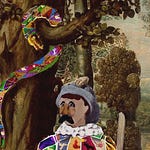XXI. LUNE MALADEO Lune, nocturne phtisique, Sur le noir oreiller des cieux, Ton immense regard fiévreux M’attire comme une musique !
Tu meurs d’un amour chimérique, Et d’un désir silencieux, O Lune, nocturne phtisique, Sur le noir oreiller des cieux !
XXI. SICK MOONXXI. SICK MOON O Moon, nocturnal consumptive, on the black pillow of the skies, your immense fevered gaze pulls me to you like a piece of music!
You’re dying of a chimerical love, and of a silent desire, O Moon, nocturnal consumptive, on the black pillow of the skies!
But wrapped up in corporeal pleasure the lover who passes by without a care mistakes for rays of grace your white and melancholy blood, O Moon, nocturnal consumptive!
1 This is the third rondel in Rondels Bergamasques, where it has the same title.
2 nocturne : See VI.6.
phtisique : A ‘consumptive’, i.e., a tubercular person. According to M. D. Grmek, Diseases in the Ancient Greek World (English translation by M. and L. Muellner, Johns Hopkins University Press, Baltimore, 1989, of Les maladies à l’aube de la civilisation occidentale: recherches sur la réalité pathologique dans le monde grec préhistorique, archaïque, et classique, Payot, Paris, 1983), p. 183, “In ancient Greek the word phthisis ‘consumption, phthisis’ has a more general sense than the purely medical meaning of its calques in modern languages. When Aristotle speaks of the phthisis of the moon, he simply means that it is waning.” Might Giraud have learned about Aristotle’s φθίσις της σελήνης, ‘the consumption of the moon’, during his schooling? In 1882 Koch identified the tubercle bacillus; until then, what R. and J. Dubos (The White Plague: Tuberculosis, Man, and Society, Boston, Little, Brown, 1952, p. 11) call “the perverted attitude of the romantic era toward the disease”— the ascription of various psychological and esthetic characteristics to consump- tives, whether as causes, effects, or both, of their disease—pervaded literary and artistic culture. In this rondel Giraud projects that attitude onto the moon; in XXV, he reflects its widespread application to Chopin. The brothers Edmond and Jules de Goncourt (Watteau [etc.], Paris, E. Dentu, 1860), grouped Watteau among « mal- ades de langueur »; the current DAf calls maladie de langueur an obsolete term for la phtisie. Was Giraud aware that Watteau may have been « phtisique » ?
3 oreiller : The core meanings of E. ‘pillow’ and F. « oreiller » are nearly identical: OED defines ‘pillow’ as “A support for the head when lying or sleeping”; DAf1694 defines « oreiller » as « Coussin qu’on se met sous la teste quand on est couché », ‘A cushion that one puts under the head when one is abed’. In later editions the only changes are spelling reforms, slight rephrasings, a transient requirement (in DAf1835 and DAf1878) that the cushion be rectangular (noted by the OED for ‘pillow’ with “esp.”, but never required), and (in the current edition only) the requirements that the covering be fabric and the filling be wool, feathers, hair, or synthetic material (perhaps legal or regulatory concerns, not lexicography, motivate these bizarrely pedantic limitations). The peripheral meanings and overtones of ‘pillow’ and « oreiller » are, however, quite dissimilar. No other English word is at all closely related to ‘pillow’ (aside from a few derivatives like ‘pillow-fight’, or figurative-turned-technical meanings in mechanics, shipbuilding, architecture, etc.); in French, written and spoken alike, « oreiller » contains oreille, ‘ear’, giving the word a concrete iconicity that ‘pillow’ surely never had in English.
5 une musique : Littré provides dozens of attributed examples of the phrase; most clearly mean a piece, genre, or performance of music.
6 amour chimérique : Unlike X.12, this combination of noun and adjective is not para- doxical: sometimes « amour » really does have no real foundation.
10 In Rondels Bergamasques, commas appear after « Mais » and at the end of the line.
11 InRondels Bergamasques, commas appear after « passe » and at the end of the line.
13 sang blanc : Literally, ‘white blood’. Up-to-date schoolbooks for Giraud’s generation (e.g., Lambert, Zoologie, à l’usage des lycées [etc.], Paris, F. Savy, 1865, p. 56) taught that Aristotle’s distinction between ‘red-blooded’ animaux à sang rouge (viz., vertebrates and some annelid worms) and ‘bloodless’ animaux exsangues (inver- tebrates and other worms) had been superseded, with animaux à sang blanc as the new term for the latter. On the other hand, no later than de Lassus’s prize-winning Dissertation sur la Lymphe [etc.] (Lambert, Paris, 1744), physiologists had begun to use sang blanc for lymph; A. Wahlen’s popularizing Nouveau dictionnaire de la con- versation [etc.] (Bruxelles, Librairie-Historique-Artistique, 1845) had an article on Lymphe subtitled Sang blanc. Various sources claim, without citations, that Hippo- crates wrote of ‘white blood’; be that as it may, « sang blanc » appears nowhere in Littré’s Œuvres complètes d’Hippocrate (Paris, Baillière, 1839–1861).






